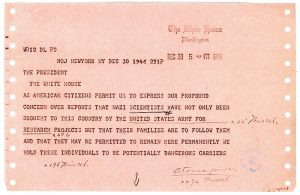Plain numerical DOI: 10.1177/0952695119872094
DOI URL
directSciHub download
Show/hide publication abstract
This article was adapted from a chapter of the PhD thesis Battles for the Mind: Brainwashing Altered States and the Politics of the Nervous System (1945-1970), completed at Birkbeck in 2018.
Abstract
The personal papers of the neurophysiologist John C. Lilly at Stanford University hold a classified paper he wrote in the late 1950s on the behavioural modification and control of ‘human agents’. The paper provides an unnerving prognosis of the future application of Lilly’s research, then being carried out at the National Institute of Mental Health. Lilly claimed that the use of sensory isolation, electrostimulation of the brain, and the recording and mapping of brain activity could be used to gain ‘push-button’ control over motivation and behaviour. This research, wrote Lilly, could eventually lead to ‘master- slave controls directly of one brain over another’. The paper is an explicit example of
Lilly’s preparedness to align his research towards Cold War military aims. It is not, however, the research for which Lilly is best known. During the 1960s and 1970s, Lilly developed cult status as a far-out guru of consciousness exploration, promoting the use of psychedelics and sensory isolation tanks. Lilly argued that, rather than being used as tools of brainwashing, these techniques could be employed by the individual to regain control of their own mind and retain a sense of agency over their thoughts and actions. This article examines the scientific, intellectual, and cultural relationship between the sciences of brainwashing and psychedelic mind alteration. Through an analysis of Lilly’s autobiographical writings, I also show how paranoid ideas about brainwashing and mind control provide an important lens for understanding the trajectory of Lilly’s research.
The ‘Cold War brainwashing scare’
Lilly’s appointment to the NIMH came shortly after a new term – brainwashing – had been introduced into the English language. The term was first used publicly by journalist Edward Hunter in an article for the Miami News (1950).7 In this article and in later works, Hunter claimed that by combining Pavlovian theory with modern technology, Russian and Chinese psychologists had developed powerful techniques for manipulating minds. Although it resonated with concerns about the growing global influence of communism, the term brainwashing would perhaps never have gained traction if it had not been for a series of scandals involving collaboration between American POWs and the Chinese enemy during the Korean War. Most famously, in 1952, Colonel Frank Schwable and 35 other captured US Air Force personnel publicly confessed to committing crimes of germ warfare against North Korea. Other accounts of collaboration at the hands of the Chinese, including the making of public anti-war and anti-McCarthy broadcasts, received widespread attention during the war. Perhaps most controversially, after a long-awaited armistice deal was agreed in 1953, one British and 21 American POWs refused to be repatriated after the war, choosing to relocate to communist China instead. It was widely reported that the soldiers had been exposed to sophisticated techniques of mental coercion based on Pavlovian science, similar to those reported to have been used to extract confessions for Soviet purge trials such as that of Cardinal József Mindszenty in 1949 (Carruthers, 2009).
Scholarship on this period has described the ‘Cold War brainwashing scare’, the ‘brainwashing idea’, and the ‘spectre of brainwashing’, as a central motif in postwar film and literature upon which myriad concerns about agency and influence were projected (for use of these phrases see, respectively, Carruthers, 1998; Reisch, 2012; Taylor, 2004). Whilst such scholarship has often described brainwashing as a ‘cultural fantasy’, the idea of brainwashing nonetheless had real effects, not least within the human sciences. In the early 1950s, building on investigations carried out since the Second World War, the CIA established its notorious MKULTRA programme, which aimed, in the words of its former director Sidney Gottlieb, to ‘investigate whether and how it was possible to modify an individual’s behaviour by covert means’ (Marks, 1978: 57). What the historian Alfred McCoy has called ‘the Manhattan Project of the mind’ was fuelled by a dual sense of hubris about the CIA’s own research and development potential and paranoia about the capabilities of the enemy, enhanced, as it were, by the semi-tangible reports of enemy scientific projects within what Melley has called the ‘covert sphere’ (McCoy, 2006; Melley, 2012).
According to his own memoirs, Lilly had long been interested in questions of behavioural control. It was reportedly his reading of Aldous Huxley’s Brave New World in 1934 and its portrayal of the misuse of the human sciences that influenced his decision to major in biology rather than physics as a student (Lilly, 1997: 57). Although Lilly has somewhat successfully cultivated an image of himself as someone who resisted the lure of military and intelligence funding, like many of his peers, his work and career was heavily shaped by the wider forces shaping the human sciences after the war (Lutz, 1997; McCoy, 2006).
*Lilly, ‘Special Considerations of Modified Human Agents as Reconnaissance and Intelligence Devices (Committee D, Intelligence and Reconnaissance)’, Lilly Papers, Box 54, Folder 17. Exactly when and where this paper was delivered is unclear. In his paper on human manipulation, Lilly implies that both papers were presented at the same place or at connected events: ‘In the following discussion I wish to mention a few human cases; a later supplement will mention certain non-human species as possible agents.’ It is likely that this work or similar was presented at the Pentagon meeting discussed in Lilly’s memoirs (Lilly, 1997: 93–5). According to a former intelligence official’s description of this meeting ‘Dr. Lilly stated that the potential of this technique in “brain-washing” or interrogation or in the field of controlling the actions of humans and animals is almost limitless’: memorandum, Jones to Deloach, 2, FBI personal file, as quoted in Burnett (2016). However, an old inventory for Lilly’s archive from 1992 includes the entry ‘Manuscript of Presentation Given to GAP Symposium on Brainwashing Entitled: “Special Considerations of Modified Human Agents as Reconnaissance and Intelligence Devices”: November 1956’, suggesting that Lilly may have delivered this paper at a meeting for the Group for the Advancement of Psychiatry, which we know he attended (Group for the Advancement of Psychiatry, 1956). Yet this is further complicated by the fact that both papers include references dated as late as 1958, suggesting the papers in the archive were presented after 1956.
www.ncbi.nlm.nih.gov/pmc/articles/PMC6899429/pdf/10.1177_0952695119872094.pdf

Further References
Bexton W. H., Heron W., Scott T. H. (1954) ‘Effects of Decreased Variation in the Sensory Environment’, Canadian Journal of Psychology
8(2): 70–6. [PubMed] [Google Scholar]
Brenninkmeijer J. (2010) ‘Taking Care of One’s Brain: How Manipulating the Brain Changes People’s Selves’, History of the Human Sciences
23(1): 107–26. [PubMed] [Google Scholar]
Burnett D. G. (2012) The Sounding of the Whale: Science and Cetaceans in the Twentieth Century. Chicago: University of Chicago Press. [Google Scholar]
Burnett D. G. (2016) ‘Adult Swim: How John C. Lilly Got Groovy (and Took the Dolphin With Him), 1958–1968’, in Kaiser D., McCray W. P. (eds) Groovy Science: Knowledge, Innovation, and American Counterculture. Chicago: University of Chicago Press, pp. 13–50. [Google Scholar]
Cameron D. E. (1950) General Psychotherapy. New York: Grune & Stratton. [Google Scholar]
Carruthers S. L. (1998) ‘“The Manchurian Candidate” (1962) and the Cold War Brainwashing Scare’, Historical Journal of Film, Radio and Television
18(1): 75–94. [Google Scholar]
Carruthers S. L. (2009) Cold War Captives: Imprisonment, Escape, and Brainwashing. Berkeley: University of California Press. [Google Scholar]
Clarke B. (2014) ‘John Lilly, The Mind of the Dolphin, and Communication Out of Bounds’, communication +1
3(1): Article 8, available at: scholarworks.umass.edu/cpo/vol3/iss1/8. [Google Scholar]
Cooper G. (1986) Opinion of George Cooper, Q.C., Regarding Canadian Government Funding of the Allan Memorial Institute in the 1950’s and 1960’s. Ottawa: Minister of Supply and Services Canada. [Google Scholar]
Dearden B., director (1963) The Mind Benders [Motion picture]. UK: Anglo-Amalgamated. [Google Scholar]
Dror O. E. (2016) ‘Cold War “Super-Pleasure”: Insatiability, Self-Stimulation, and the Postwar Brain’, Osiris
31(1): 227–49. [PubMed] [Google Scholar]
Dunne M. W. (2013) A Cold War State of Mind: Brainwashing and Postwar American Society. Amherst: University of Massachusetts Press. [Google Scholar]
Foucault M. (1988) Technologies of the Self: A Seminar with Michel Foucault, ed. Martin L. H., Gutman H., Hutton P. H.
Amherst: University of Massachusetts Press. [Google Scholar]
Group for the Advancement of Psychiatry (1956) ‘Symposium No. 3: Factors Used to Increase the Susceptibility of Individuals to Forceful Indoctrination: Observations and Experiments’, available at: ourgap.org/resources/Documents/Symposiums/3-symposiums_factors_usedto_incre.pdf.
Hebb D. O. (1958) ‘The Motivating Effects of Exteroceptive Stimulation’, American Psychologist
13(3): 109–13. [Google Scholar]
Heron W. (1961) ‘Cognitive and Physiological Effects of Perceptual Isolation’, in Solomon P., Kubzansky P. E., Leiderman P. H., Mendelson J. H., Trumbull R., Wexler D. (eds) Sensory Deprivation: A Symposium Held at Harvard Medical School. Cambridge, MA: Harvard University Press, pp. 7–33. [Google Scholar]
Hofstadter R. (1964, 15
November) ‘The Paranoid Style in American Politics’, Harper’s Magazine, 77–86. [Google Scholar]
Holmes M. (2017. a) ‘Brainwashing the Cybernetic Spectator: The Ipcress File, 1960s Cinematic Spectacle and the Sciences of Mind’, History of the Human Sciences
30(3): 3–24. [PMC free article] [PubMed] [Google Scholar]
Holmes M. (2017. b, 26
May) ‘Edward Hunter and the Origins of “Brainwashing”’, Hidden Persuaders, available at: www.bbk.ac.uk/hiddenpersuaders/blog/hunter-origins-of-brainwashing/.
Hunter E. (1950, 24
September) ‘“Brain-Washing” Tactics Force Chinese into Ranks of Communist Party’, Miami Daily News, p. 2. [Google Scholar]
Jeffrey F., Lilly J. C. (1990) John Lilly, So Far. Los Angeles: Jeremy P. Tarcher. [Google Scholar]
Kaiser D., McCray W. P., eds (2016) Groovy Science: Knowledge, Innovation, and American Counterculture. Chicago: University of Chicago Press. [Google Scholar]
Labor-Health, Education, and Welfare Appropriations for 1957: Hearings on H.R. 9720, 84th Cong. 553 (1956) (statement of Dr Robert H. Felix), available at: hdl.handle.net/2027/uc1.b3636813.
Langlitz N. (2006) ‘Tripping in Solitude: Introducing Honza Samotar by Way of John Lilly’, in Solhdju K. (ed.) Introspective Self-Rapports: Shaping Ethical and Aesthetic Concepts, 1850–2006 (Preprint
322). Berlin: Max Planck Institute for the History of Science, pp. 81–92. [Google Scholar]
Lemov R. (2011) ‘Brainwashing’s Avatar: The Curious Career of Dr. Ewen Cameron’, Grey Room
45: 61–87. [Google Scholar]
Lilly J. C. (1950) ‘A Method of Recording the Moving Electrical Potential Gradients in the Brain: The 25-Channel Bavatron and Electro-Iconograms’, in American Institute of Electronic Engineers (eds) Conference on Electronic Instrumentation in Nucleonics and Medicine
New York: American Institute of Electronic Engineering, pp. 37–3. [Google Scholar]
Lilly J. C. (1955, 13
November) ‘Some Thoughts on Brain-Mind and on Restraint and Isolation of Mentally Healthy Subjects’, paper presented at the meeting of the Group for the Advancement of Psychiatry, Asbury Park, NJ. [Google Scholar]
Lilly J. C. (1958. a) ‘Learning Motivated by Subcortical Stimulation: The “Start” and the “Stop” Patterns of Behavior’, in Jasper H. H., Proctor L. D., Knighton R. S., Noshay W. C., Costello R. T. (eds) Reticular Formation of the Brain: Henry Ford Hospital International Symposium. Boston: Little Brown, pp. 705–21. [Google Scholar]
Lilly J. C. (1958. b) ‘Electrode and Cannulae Implantation in the Brain by a Simple Percutaneous Method’, Science
127: 1181–2. [PubMed] [Google Scholar]
Lilly J. C. (1961) Man and Dolphin. Garden City, NY: Doubleday. [Google Scholar]
Lilly J. C. (1972) Programming and Metaprogramming in the Human Biocomputer: Theory and Experiments. New York: Julian Press. [Google Scholar]
Lilly J. C. (1973) The Centre of the Cyclone: An Autobiography of Inner Space. London: Calder & Boyars. [Google Scholar]
Lilly J. C. (1978) The Scientist: A Novel Autobiography. Philadelphia: Lippincott. [Google Scholar]
Lilly J. C. (1988) The Scientist: A Metaphysical Autobiography (2nd ed). Berkeley: Ronin. [Google Scholar]
Lilly J. C. (1997) The Scientist: A Metaphysical Autobiography (3rd ed). Berkeley: Ronin. [Google Scholar]
Lilly J. C., Hughes J. R., Alvord E. C., Jr, Galkin T. W. (1955) ‘Brief, Noninjurious Electric Waveform for Stimulation of the Brain’, Science
121(3144): 468–9. [PubMed] [Google Scholar]
Lilly J. C., Shurley J. T. (1961) ‘Experiments in Solitude, in Maximum Achievable Physical Isolation With Water Suspension, of Intact Healthy Persons’, in Flaherty B. E. (ed.) Psychological Aspects of Space Flight. New York: Columbia University Press, pp. 238–47. [Google Scholar]
Lutz C. (1997) ‘The Psychological Ethic and the Spirit of Containment’, Public Culture
9(2): 135–59. [Google Scholar]
Marks J. (1978) The Search for the ‘Manchurian Candidate’: The CIA and Mind Control. New York: Times Books. [Google Scholar]
McClen R., Brown D. J. (2013) ‘John C. Lilly Interviewed’, Awaken, available at: www.awaken.com/2013/03/john-c-lilly-interviewed/.
McCoy A. W. (2006) A Question of Torture: CIA Interrogation, From the Cold War to the War on Terror. New York: Metropolitan. [Google Scholar]
Melley T. (2000) Empire of Conspiracy: The Culture of Paranoia in Postwar America. Ithaca: Cornell University Press. [Google Scholar]
Melley T. (2011) ‘Brain Warfare: The Covert Sphere, Terrorism, and the Legacy of the Cold War’, Grey Room
45: 19–41. [Google Scholar]
Melley T. (2012) The Covert Sphere: Secrecy, Fiction, and the National Security State. Ithaca: Cornell University Press. [Google Scholar]
Oaklander M. (2015, 18
November) ‘Behind the Strange New Science of Floating’, TIME.com, available at: time.com/floating/.
Pickering A. (2008, 24/25
April) ‘Brains, Selves and Spirituality in the History of Cybernetics’, paper presented at the Transhumanism and the Meaning of Progress workshop, Arizona State University, 24–25 April 2008, available at: ore.exeter.ac.uk/repository/bitstream/handle/10036/81576/ASU-spirit.pdf?sequence=2&isAllowed=y. [Google Scholar]
Pickering A. (2010) The Cybernetic Brain: Sketches of Another Future. Chicago: University of Chicago Press. [Google Scholar]
Raz M. (2013) ‘Alone Again: John Zubek and the Troubled History of Sensory Deprivation Research’, Journal of the History of the Behavioral Sciences
49(4): 379–95. [PubMed] [Google Scholar]
Reisch G. (2012) ‘The Paranoid Style in American History of Science’, Theoria
27(3): 323–42. [Google Scholar]
Rose N. (1998) Inventing Our Selves: Psychology, Power, and Personhood. Cambridge: Cambridge University Press. [Google Scholar]
Roszak T. (1969) The Making of a Counter Culture: Reflections on the Technocratic Society and Its Youthful Opposition. Berkeley: University of California Press. [Google Scholar]
Russell K., director (1980) Altered States [Motion picture]. USA: Warner Brothers. [Google Scholar]
Seed D. (2004) Brainwashing: The Fictions of Mind Control: A Study of Novels and Films Since World War II. Kent, OH: Kent State University Press. [Google Scholar]
Shiga J. (2013) ‘Of Other Networks: Closed-World and Green-World Networks in the Work of John C. Lilly’, Amodern
2, available at: amodern.net/article/of-other-networks/.
Shurley J. T. (1992) ‘Sensory Deprivation and Sensory Isolation Research, and Political Torture: A 35-Year Critical Retrospective’, in Kales A., Pierce C. M., Greenblatt M. (eds) The Mosaic of Contemporary Psychiatry in Perspective. New York: Springer, pp. 200–10. [Google Scholar]
Suedfeld P. (1980) Restricted Environmental Stimulation: Research and Clinical Applications. New York: Wiley. [Google Scholar]
Szasz T. S. (1965) Psychiatric Justice. New York: Macmillan. [Google Scholar]
‘Tank Test Linked to Brainwashing; U.S. and Canadian Scientists Report to Congress on Their Experiments’ (1956, 15
April) New York Times, p. 18. [Google Scholar]
Taylor K. (2004) Brainwashing: The Science of Thought Control. Oxford: Oxford University Press. [Google Scholar]



![J. Edgar Hoover on "monstrous conspiracy and morality" 475px-Hoover-JEdgar-LOC[1]](https://cognitive-liberty.online/wp-content/uploads/475px-Hoover-JEdgar-LOC1-238x300.jpg)





![Testing Theories of American Politics 9780691162423_0[1]](https://cognitive-liberty.online/wp-content/uploads/9780691162423_01-199x300.png)